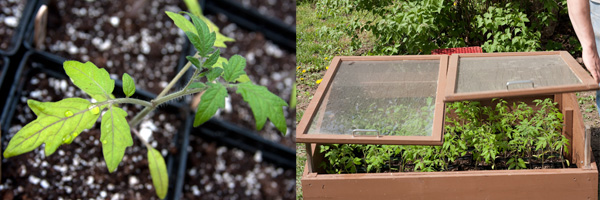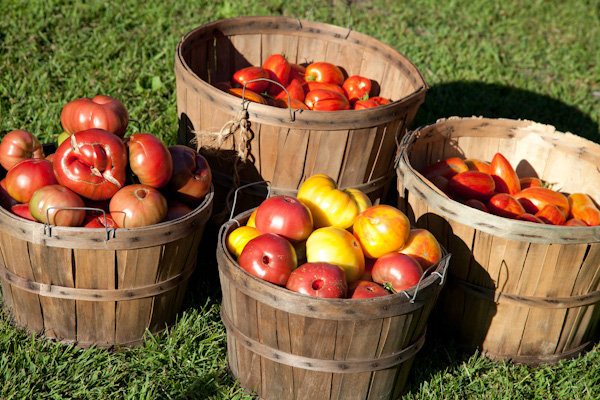 I’m not crazy about summer ending. I never am. I love summer, even the really hot days. I find it easier to cool off in the summer then to warm up in the winter. Don’t get me wrong, I’m a big fan of living where there are four distinct seasons and there are many things I love about each season, but summer, summer is my favorite. Although we are well into fall I am still saying good-bye to summer by squeezing in as much outdoor time as I can on the lingering warm days and by covering the garden when there is a chance of frost so that it can continue to produce. But it’s time to say good-bye and that includes saying good-bye to our 56 heirloom tomatoes plants.
I’m not crazy about summer ending. I never am. I love summer, even the really hot days. I find it easier to cool off in the summer then to warm up in the winter. Don’t get me wrong, I’m a big fan of living where there are four distinct seasons and there are many things I love about each season, but summer, summer is my favorite. Although we are well into fall I am still saying good-bye to summer by squeezing in as much outdoor time as I can on the lingering warm days and by covering the garden when there is a chance of frost so that it can continue to produce. But it’s time to say good-bye and that includes saying good-bye to our 56 heirloom tomatoes plants.
It’s fair to say that our tomato plants are the most important vegetable we grow. We start the seeds in February from seeds saved from tomatoes the year before. We pamper the seedlings along under grow lights with a space heater to keep them warm and an oscillating fan to strengthen them. Then, in April, the seedlings get moved to bigger pots and fed organic fertilizer. As soon as the days start warming up, the plants get shuffled in and out to start the hardening-off process and, eventually, sometime early in May, I have a restless night of sleep concerned about the plants as they spend their first cool night outside in the hardening box.

Sometime around the middle of May, when the forecast appears to be frost-free, the tomatoes get planted in the garden. The rows are planned out, the stakes are pounded in and a special just-for-our-tomatoes drip irrigation system is laid down. As for planting the tomatoes, we don’t just dig holes and plop them in. No way! They get the royal treatment with black garden cloth, rich organic compost from the compost bin, and a system of planting that Chris jokingly calls The Savage Method, a planting procedure that I came up with to protect the plants from early blight. They always look so fragile in the ground right after planting so there is a fair amount of worrying as the first few unstable weather patterns pass through.
The tomatoes get put on a regular watering schedule and get checked daily for problems such as cut worms. As they grow taller, they get tidied up weekly with a technique called the “Flordia Weave” to keep them up off the ground. Then there’s the tomato horn worm. We watch closely for signs of these nasty destructive worms. We don’t always get them, but when we do it’s a twice a day hunt to remove them. You can’t miss a day or they could destroy most of a plant. This year was a bad year and we removed nearly 100 of those despicable pests.
Now it’s late July and hot and humid and we’re weaving the plants and picking off worms and cutting low branches and cringing at the first signs of blight and, as we stand there surrounded by tomato plants and mosquitos, one of us inevitably says, “Why do we do this every year?” A question answered only after biting into that first perfectly ripe tomato: “This is why.”
We love our tomatoes, but it’s time to say good-bye.

 These plants have given us a lot. We’ve been eating fresh tomatoes for two months and canned 54 quarts, but last Saturday, after we made the decision not to cover them any more if frost is in the forecast. This decision made me a little sad because they were are still covered with green tomatoes. I wanted to do all I could to get the tomatoes red, so I did a little research I found something referred to as root pruning. Basically you sever some of the roots to shock the plant and this, in turn, sends a signal to the tomatoes to ripen. I had my doubts, but I tried it and a week later it appears to be working! By this weekend I should be able to harvest a bunch of red tomatoes.
These plants have given us a lot. We’ve been eating fresh tomatoes for two months and canned 54 quarts, but last Saturday, after we made the decision not to cover them any more if frost is in the forecast. This decision made me a little sad because they were are still covered with green tomatoes. I wanted to do all I could to get the tomatoes red, so I did a little research I found something referred to as root pruning. Basically you sever some of the roots to shock the plant and this, in turn, sends a signal to the tomatoes to ripen. I had my doubts, but I tried it and a week later it appears to be working! By this weekend I should be able to harvest a bunch of red tomatoes.
So, in honor of our wonderful tomatoes plants, I will use the last tomatoes to make a large batch of tomato sauce. To this sauce I will add a few peppers from the garden, ripe and red. I will add onions and garlic, both from our garden, already harvested and just waiting for their next recipe. I will also add to this sauce the last of the zucchinis, parsley and basil and a healthy bunch of oregano before it hibernates for the winter. The sauce will go into tupperware containers and put in the freezer.
Sometime in the middle of winter the last container of sauce will be taken out of the freezer, thawed and eaten for dinner.
Maybe that will be the night we pull out our garden log and make plans for our next garden.
I love that first photo! I whole-heartedly agree about not wanting tomato season to end.
Can you describe how you sever the roots”? I think we could do this with our tomatoes before saying “buh bye”.
Tom, thanks for asking. I took a long serrated knife (one of our extra bread knives) and cut a semi-circle around the base of the plant about 2-3 inches from the stem. I went 8 inched down. Basically I cut away half the roots. Does that make sense?
You bet. Thanks!